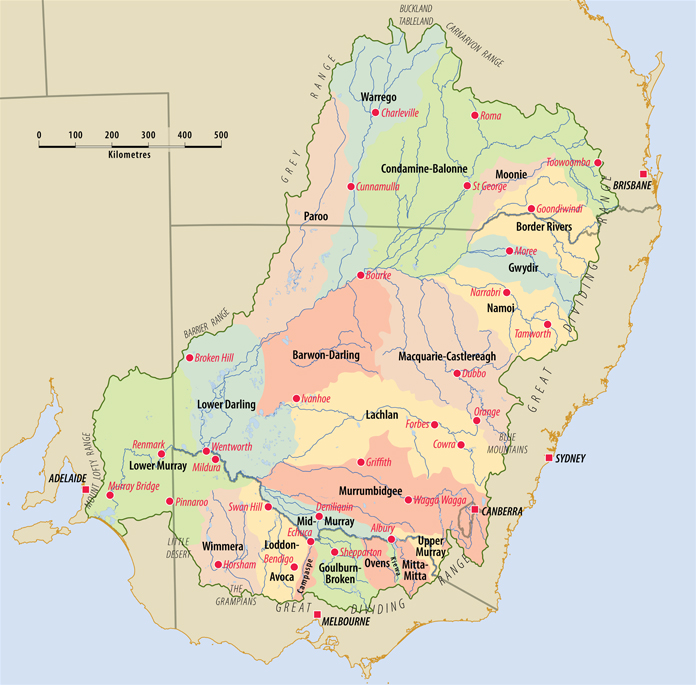Expensive deals done in private have made no difference to the Murray-Darling’s environmental woes. Our biggest river system is dying.

What do Charleville and Toowoomba, Broken Hill and Bathurst, Bendigo and Horsham, Morgan and Mount Barker and Canberra have in common?
As you probably know, it’s the Murray-Darling river system, which waters about 40 per cent of Australian farm production and drains over a million square kilometres.
“Drains” might be overstating it; way before the Murray mouth in South Australia, most water entering the basin is captured in some dam or ditch, or taken up by crops or stock. Or it simply evaporates.
The fact that upstream properties and jurisdictions exercise power over those in lower reaches – and the devastating impact of this on wetlands and other natural assets – is the reason the Murray-Darling Basin Authority was formed 11 years ago, and the basis of the 2012 basin plan.
The plan seeks to resolve a century of bickering over water rights between property owners, local councils and states by ensuring that the basin’s water is allocated fairly to meet economic, social and environmental needs. If that seems straightforward, it isn’t.
Raised on a Darling basin tributary near Tamworth (now his base as MP for New England), Barnaby Joyce is a child of the Murray-Darling. As a long-time resident of St George on the Balonne River, part of the Darling’s northern catchment, he was a senator for Queensland.
Numerous properties around St George including Kia Ora, just 5 km away, and Clyde, about 70 km southwest, take water from the Balonne to irrigate grain and cotton crops. Two months ago those two stations were put up for sale by their owner, Eastern Australia Agriculture.
Water storage is a high priority for properties around St George. Kia Ora, Clyde and its next door neighbour, Cubbie, all have big dams designed to capture water overflowing from the Balonne when it floods – water that in earlier times replenished the Darling’s arid lower reaches.
Joyce is a big advocate for dams and pipelines, even to the extent of capturing tropical rainwater and piping it thousands of kilometres into the Murray-Darling. That mindset heavily influenced his thinking as water resources minister from 2013 to 2017.
The principal aim of the Murray-Darling plan is not holding water back but allowing it to run. Water buyback tries to make more water available for the basin’s natural environment, notably its wetlands, by purchasing entitlements from private users prepared to give them up.
At first the plan used an open tender process, generally regarded as most cost-effective. But Joyce thought subsidising irrigators to improve water efficiency was a better use of public money.
Water buybacks did not stop, however – they were just negotiated behind closed doors. This was said to cut red tape and improve efficiency, but who can tell when the deal is done in private?
Two weeks ago, Ten Network’s The Project looked at one of those deals involving the two Balonne properties owned by Eastern Australia Agriculture, Kia Ora and Clyde, in which the government paid EAA around $80 million for rights to 28.7 gigalitres of overflow water.
The location of EAA’s parent company in the Cayman Islands and the involvement (if any) of energy minister Angus Taylor, a co-founder of EAA, may have something to say about the decision, but in the final analysis the issue is how this sale benefited the Murray-Darling.
The federal agriculture department responded that the deal produced “clear and very significant” environmental benefits for downstream wetlands. But these can only be realised when there are floods, and there haven’t been any since the deal. We just don’t know if that’s true.
We know too little overall about how water buyback money is being spent – who benefits and what conflicts of interest may be in play – but dying rivers are telling us it isn’t working as it should.
In a report it released in February, the Wentworth Group of Concerned Scientists, which has kept a watching brief on the Murray-Darling plan since its inception, panned the $8.5 billion expenditure on environmental water recovery from 2010 to 2018.
“Environmental flow targets set by the Murray-Darling Basin Authority… have failed to be achieved,” it said. “Instead of an increase there has actually been no improvement or even a decline in water flows since the implementation of the Basin Plan.”
For five years as minister, Barnaby Joyce never ceased railing against such conclusions. His accountancy training didn’t help him see that of the three elements of the triple-bottom-line – economic, social and environmental – the last is most crucial to a healthy Murray-Darling system.
We don’t need the Wentworth Group to tell us the system is seriously ill; dead fish in January told us that. The intricate irrigation systems which once made the Murray-Darling work for us are now working against us as competing interests continue to battle over diminishing water.
The Murray-Darling is in crisis, which means the country is also in crisis. We don’t need plodding re-statements of the thinking that got us into this. We need ministers and governments to acknowledge that things have now changed, radically and forever, and then to govern accordingly.
